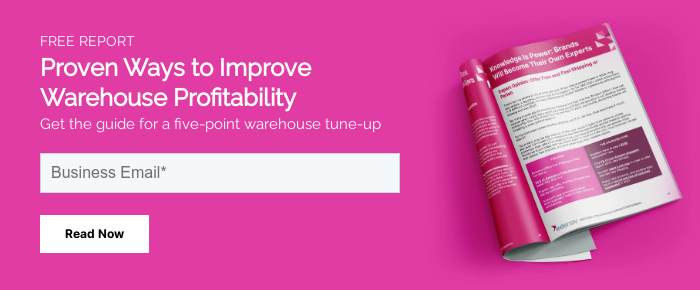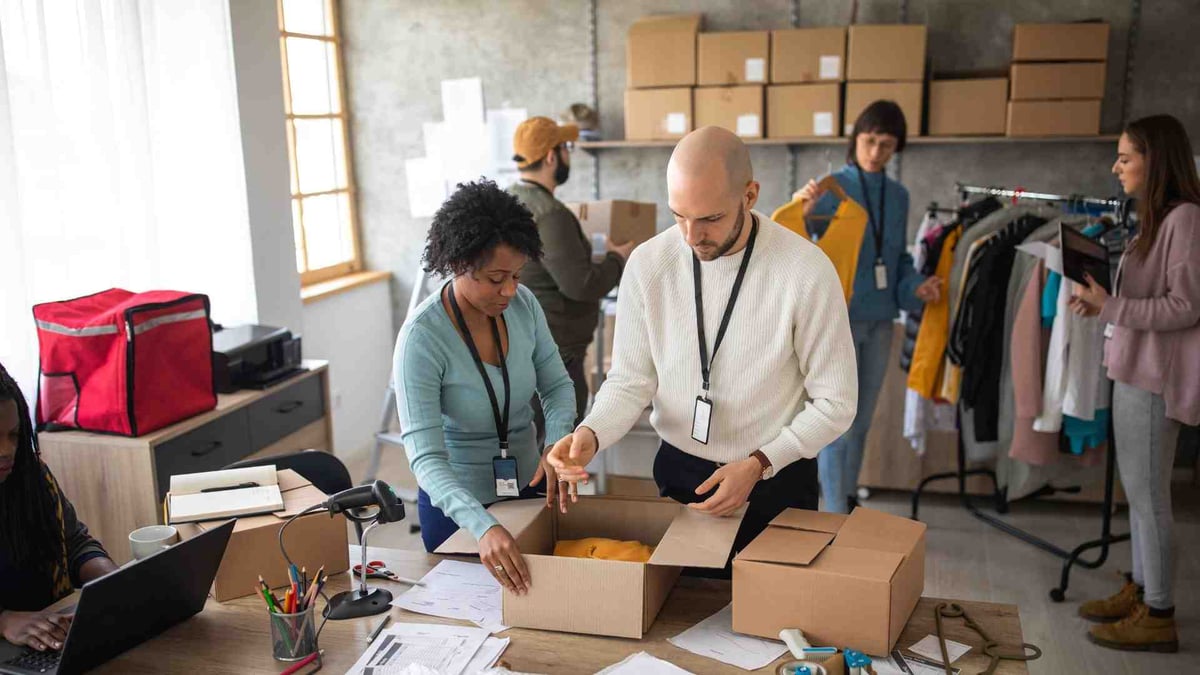Even if you have the sleekest website design and the catchiest email copy, your third-party logistics (3PL) warehouse can only go so far without the right ecommerce fulfillment strategy in place. A strong approach to ecommerce order fulfillment will not only satisfy customer expectations, but it’ll likely be the reason they keep doing business with you (instead of giving their money to a competitor).
In many ways, ecommerce fulfillment is the deciding factor in which companies and 3PLs sink or soar. If the entire process doesn’t run smoothly, your 3PL will be on the fast track toward losing customers and countless sales opportunities.
Keep reading to dig into all the details of the ecommerce order fulfillment process—and to find out how you can better manage these moving pieces to ensure your 3PLs’s success.
How has ecommerce fulfillment changed from 2020 to 2022?
Although ecommerce fulfillment has been around for decades, the last few years have brought about change (and disruption) like never before. It’s no secret that global supply chains experienced a very tumultuous year in 2020. On top of the onset of a global pandemic, there were also massive labor shortages and a lack of raw materials to contend with.
The following year brought about some of the same supply chain challenges—but with the addition of port congestion, manufacturing delays, and extreme weather events like hurricanes and wildfires. And that all goes without mentioning a slew of outliers that few people saw coming: new COVID variants, factory shutdowns, and the global phenomenon that was the trapped Ever Given shipping carrier.
Now in 2022, 3PLs from all over the world are trying their best to navigate inflation, resignations, war (and the list goes on). It’s certainly a precarious time to be a 3PL provider, and yet, resilience continues to shine through.
Ecommerce stores and 3PLs alike are learning to find a balance between maximizing the value of their storage space while maintaining a steady flow of inventory. In addition, omnichannel fulfillment has continued to grow in popularity as companies seek to expand their sales channels but leverage the same inventory to fulfill all incoming orders.
Lastly, technology is also transforming at a rapid pace. Countless 3PLs are shifting to highly adaptable, cloud-based software that optimizes fulfillment innovations and quickly integrates within the broader logistics ecosystem.
Although this technology won’t magically fix all the issues with your supply chain and/or ecommerce fulfillment, it’s definitely a step in the right direction. These updates do a lot to ensure your warehouse stays profitable even during months or years of unforeseen circumstances—case in point, the Amazon effect.
With Amazon becoming such a giant in the world of fulfillment, consumers are expecting fast (and free) delivery on every order they place. As a result, 3PLs have started banding together to create 4PL networks that expand their geographical footprint. In other words, 4PL providers are able to shorten their delivery windows, reduce total overhead costs, and delight their customers at the very same time.
Extensiv has addressed the Amazon effect head on with the Network Manager solution. This latest technology allows you to build your own 4PL alongside other participating 3PL providers. In doing so, you can capitalize on your customer relationships without involving any middle men who are likely to create bottlenecks in your processes and communication. In short, Network Manager streamlines all your inventory visibility and order routing across multiple facilities, so you can operate with ease (and at a much greater speed).
The impact of ecommerce fulfillment on 3PL businesses
When you have a good handle on ecommerce fulfillment, it can have an amazing impact on your entire business. Not only does optimized fulfillment translate to increased customer loyalty, but it also improves efficiency, lowers shipping costs, and extends the reach of your warehouse.
Increases customer loyalty
One of the best things about well-executed fulfillment is that it elevates the entire customer experience. When your warehouse keeps its promise for fast (and affordable) delivery, it builds trust among your client base—and helps you earn a reputation as a reliable ecommerce partner. Simply put, a hassle-free experience makes companies more likely to work with you in the future, which means greater loyalty and more consistency with your revenue streams.
Improves efficiency
By integrating your warehouse's fulfillment with an inventory management, order management, or warehouse management system (WMS), you can improve the efficiency of your operations in a snap. Using these ecommerce platforms allows you to enjoy peak organization, analytics, and visibility on all product movement. And these are exactly the qualities you need to run a streamlined warehouse that has an eye on everything its inventory is doing (at any given time).
Lowers shipping costs
Third-party logistics providers have tremendous bargaining power with major worldwide shippers—due to the large number of packages they ship (and the fact that they ship for multiple companies). This bargaining power can be leveraged to lower shipping fees even further, allowing your clients to enjoy greater cost savings in both the short- and long-term. Overall, this frees up a lot of working capital which can then be reinvested in your business.
Extends ecommerce reach
The leading 3PLs have the necessary framework to pick, pack, and ship orders anywhere in the world without a second thought. This optimized fulfillment can help ecommerce merchants ship exponentially more orders as compared to relying on a logistics infrastructure of their own. In that way, 3PLs significantly extend the reach of ecommerce businesses, allowing them to enter into new markets and territories they otherwise wouldn’t have had access to.
5 steps in the ecommerce fulfillment process
While the ecommerce fulfillment process is generally fairly simple, it does follow a pretty structured set of five steps. These steps include order receiving, order processing, picking and packing, shipping, and returns—all of which is discussed in more detail below.
Order receiving
Ecommerce fulfillment kicks off when an order is received through an online store. In this initial step, a retailer accepts the order and collects payment from the customer. Note that using a multichannel or omnichannel fulfillment tool can really streamline things on the backend. This kind of software automatically transfers information (like shipping details and delivery addresses) from ecommerce sales channels to the preferred order management system (OMS) or WMS.
Order processing
The next step in ecommerce fulfillment is order processing. This is where order details are passed on to the appropriate warehousing or distribution center—and where the fulfillment team starts preparing products for shipment. If fulfillment is outsourced to a dropshipping company or a 3PL provider, then retailers can actually gloss over this step altogether since the service provider will take care of order processing on the company’s behalf.
Picking and packing
Picking and packing are the middle steps in ecommerce order fulfillment. At this point, select SKUs are pulled from stored inventory levels (i.e. picked from warehouse shelves). Once every item has been picked, they should be transferred to a packing station.
Keep in mind that the packing phase is more involved than placing items in a box and moving them over to the shipping department. It’s also the time to make sure each item has the required packaging, cushioning, or padding to reach the end consumer in good condition.
Shipping
After the order is properly picked and packed, the shipping process will come next. The number of shipping options available today can sometimes make your head spin.
There’s flat rate, priority, first class, three-day, two-day, and even next-day shipping. And that doesn’t touch on the differences between road, rail, ocean, and air transportation, too. The trick is to find the most cost-effective shipping rates that won’t destroy your ecommerce customer’s margins.
Whoever’s working at the shipping station is responsible for three main tasks:
- Attaching the correct shipping label and packing slip to the order
- Marking the order as ‘shipped’ in the appropriate sales channel system
- Emailing customers to confirm shipping costs and tracking numbers
It’s important for retailers to track orders, as well. Using an order management system allows the seller to track shipping times right along with their customers. With these insights at the brand’s disposal, there’s a much greater chance orders will arrive right when expected.
Returns
With shipping and delivery complete, the final stage of ecommerce order fulfillment pertains to after-sales communication—which often involves refunds, exchanges, and returns processing.
The warehouse team is responsible for conducting a quality check on any items that are sent back to the ecommerce fulfillment center. Returned products can either be restocked in inventory storage or returned to the manufacturer for credit. In some cases, returns may even be sent to a recycling center to cut down on unnecessary waste.
What brands look for in an ecommerce fulfillment service
There are a few key features that can build your reputation as a third-party logistics provider serving ecommerce fulfillment. Among the most important features to consider are industry experience, scalability, integration options, and customer service.
Industry experience
There’s something to be said for fulfillment providers who’ve been in the industry for several years running. This length of experience typically translates to a strong knowledge of fulfillment, and indicates that ecommerce businesses can trust this provider to get things done.
Because of their ample experience and insights, 3PLs can really lay a foundation for long-term customer relationships and brand partnerships. This kind of collaboration is the key to saving ecommerce merchants time and money—since they’re fully relying on the expertise of your 3PL to guide their shipping and fulfillment operations.
Scalability
The last thing any retailer wants from an ecommerce fulfillment service is one that puts limits on their growth potential. What they want is a 3PL partner who will also scale to meet demand—from thousands of orders shipped, to tens of thousands of orders, and beyond.
Thankfully, a warehouse management system, like Extensiv 3PL Warehouse Manager, automates tasks for each shipment and can effortlessly meet volume demands through functions like high-volume parcel shipping. With this type of scalability in tow, ecommerce merchants will feel fully supported as they continue to grow their business and reach a wider customer base.
Integration options
A 3PL warehouse has to offer full visibility to their customers—and the most effective way to do this is by using a warehouse management system. The best systems provide full shopping cart and marketplace integrations that enable a smooth transfer of all relevant data. This includes all the operational data that flows from the online platform to the warehouse to optimize picking, packing, and shipping processes (and to accelerate delivery speed).
Put another way, the most efficient warehouse management systems integrate with online storefronts to ensure rapid order processing and to streamline fulfillment. Everything kicks off as soon as a customer starts to place an order, and it’s not finalized until delivery is complete.
Customer support
Let’s face it: working with a fulfillment solution that doesn’t offer customer support is not going to be in a retailer’s best interest. These days, the leading WMS are equipped with a support team who’s ready to answer customer questions or address any concerns that might crop up during fulfillment. Regardless if inquiries are handled over the phone, email, or online chat, you want to be a fulfillment service your customers can count on past initial implementation. From your part, you can keep track and perceive how much the cost per resolution is.
Conclusion
If you want to make ecommerce fulfillment as smooth and streamlined as you can, then you’ll need to join forces with an integrated, cloud-based warehouse management system that provides your customers with real-time visibility of all aspects of the fulfillment process. Fortunately, Extensiv offers just that type of WMS. Not only does Extensiv 3PL Warehouse Manager guide your day-to-day warehouse operations, but it supports your long-term growth, as well.
That’s because Extensiv’s ecommerce solutions are foundational to increasing fulfillment speed, improving fulfillment accuracy, and keeping customers satisfied with every order. Thanks to Extensiv 3PL Warehouse Manager’s real-time automations and 4PL capabilities, warehouses of all sizes can enjoy a more integrated, productive, and profitable workspace. That must be why over 12,000 logistics professionals use Extensiv 3PL Warehouse Manager to handle their supply chain!
Interested in trying out Extensiv for yourself? Click here to schedule your free demo today.








